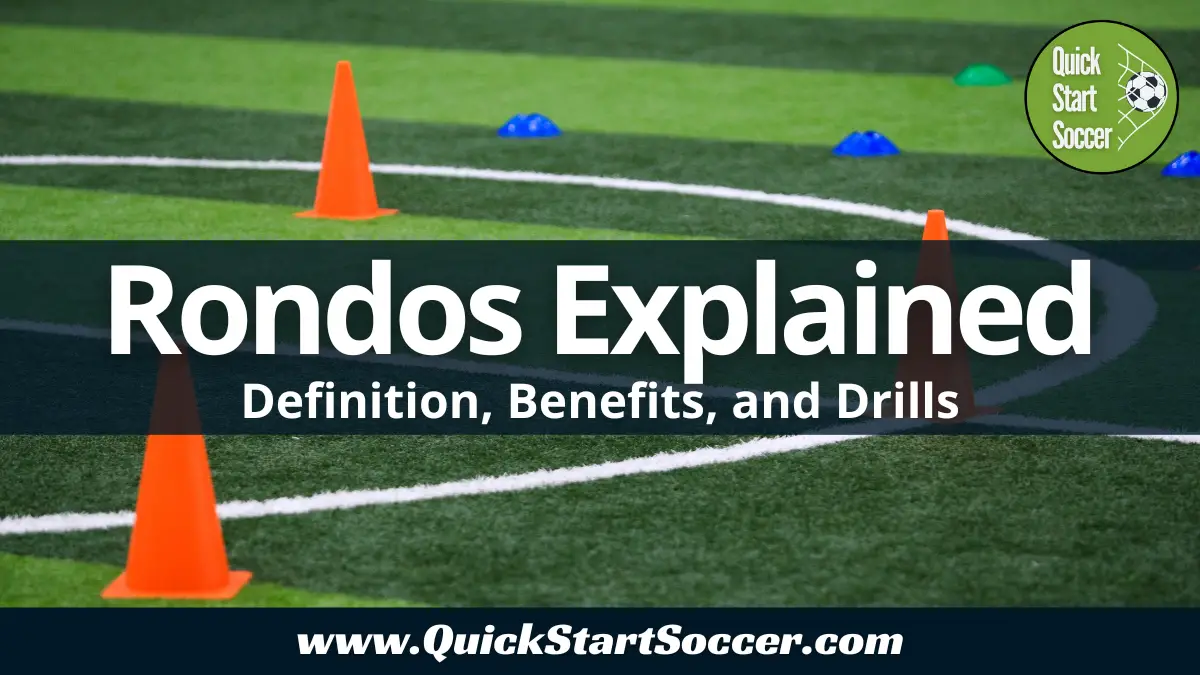Rondo In Soccer Explained | Definition, Benefits, And Drills
Rondo drills! If you’re a soccer coach, chances are you’ve heard of rondo drills, and you have probably included many of them in your coaching sessions. If you’re not sure what a rondo in soccer is, don’t worry. We’ve got you covered! In this detailed guide, we will explain the definition of a rondo in soccer, the benefits of using rondo drills in your coaching sessions, and show you some of our favorite rondo drills and games.
What Is A Rondo?
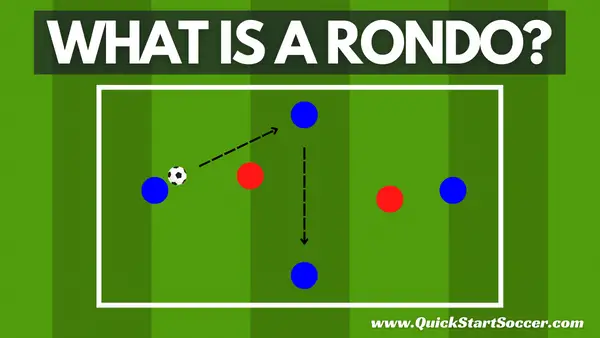
A rondo is a type of soccer drill in which the team in possession of the ball has a numerical advantage over the team not in possession of the ball. There are many different variations of rondos that are used by coaches of all levels for players of different ages and abilities.
Basic rondo’s, such as 4v2 or 3v1 drills, are often used at the start of sessions as activation activities or warm-ups. There are, however, larger and more complex rondo’s that are essentially small-sided games in which one team has a numerical advantage over the other team. These more complex rondos work on positional play, first touch, scanning, and basic spatial awareness.
Who Invented The Rondo?
The coach widely believed to have invented the rondo is called Laureano Ruiz. As head coach of the Barcelona Youth Academy in the 1970s, Ruiz impressed the club so much that he eventually took the reigns as temporary first-team coach in 1976. During his many years working with youth and adult players, Ruiz experimented with many rondo-style activities, pattern play, and positional-based exercises.
This style of coaching had a profound effect on a young player at the time, Johan Cruyff. When Cruyff returned to Barcelona as a coach in the late 1980s, the Dutch legend implemented and developed a more sophisticated player development philosophy based on positional play exercises. Central to this philosophy was the use of rondos as a technical & strategic tool to promote 1st touch, spatial awareness, and speed of ball circulation.
Cruyff was an overwhelming success at the club, winning 11 trophies between 1988 and 1996. In the modern game, Pep Guardiola is undoubtedly the most famous and successful proponent of rondos and positional play coaching. Just as Cruyff learned from playing under Ruiz, Guardiola was directly influenced by the Legacy of Cruyff as he came up as a player through the Barcelona youth and senior teams.
Benefits Of Rondo Drills
As one of the most widely used and recognized soccer drills on the planet, the rondo has many benefits for players of all ages and abilities. Here is a list of the main benefits of rondos:
- They help develop receiving the ball under pressure: Because there are always defenders in a rondo, players have consistent and frequent opportunities to receive the ball under pressure just like they would in a game.
- They help develop good vision and awareness: The fast-paced nature of rondos, often played in limited or tight spaces, means players have to play with their head up and be aware of both where the ball is coming from and where they are going to take it once they receive it.
- They develop creative passing skills: Due to the tight spaces and high pressure that often comes from the defending team, players are forced to utilize creative ways of passing the ball to avoid losing it, for example, nutmegging a player or chipping/dinking the ball off the ground slightly to lift it over their opponent’s outstretched foot.
- They encourage players to make good angles of support: To help teammates under pressure, players often have to move laterally in rondos to improve their angle of support and become clear and visible.
- They can help develop spatial and positional awareness: Whereas basic 3v1 or 4v2 rondos only help general spatial awareness, more complex rondos like Pep Guardiola’s 4v4+3 also help players understand their general positions on the field and where they should be in relation to their teammates and opponents.
- They can help defenders practice working together and providing cover and support: Although people often only think about the attacking benefits of rondos, it is important to note that they are great activities to work on defending skills too!
- They’re fun: Rondos replicate real game situations in which one team tries to keep the ball away from another, so it’s naturally fun and competitive for players of all ages and abilities.
Rondo Drills
We’ve talked a lot about rondos, who invented them, and how they can benefit your players! Now let’s look at some great rondo drills and variations you can use in your next coaching session. Here are our favorite soccer rondo drills:
3v1 Monkey In The Middle
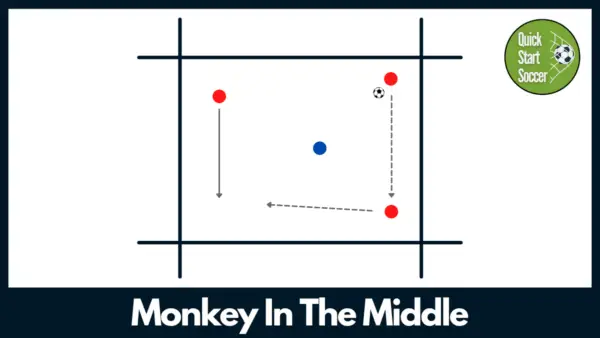
Although the name of this rondo may sound childish, it works well with players of all ages. This first rondo drill is great for working on passing, receiving, and movement skills, and is a super fun way to warm-up at the start of your coaching sessions.
How To Set Up The Drill
Split players up into teams of 4 and set up one 12×12 yard grid for every four players. In each grid, place one ball and one colored bib for the ‘monkey’.
How To Play
One player in each grid starts of as the ‘monkey in the middle’, and the remaining three players must keep the ball away from the monkey by passing to each other. If the ‘monkey in the middle’ manages to win the ball, or if one of the other players kicks the ball out, the offending player switches places with the monkey, and play continues. Once players have practiced a few times, set a limit of 2 or 3 touches on the ball.
For coaching points, coaching tips, and a free PDF of this rondo drill, visit our Monkey In The Middle drill page.
4v2 Rondo Competition
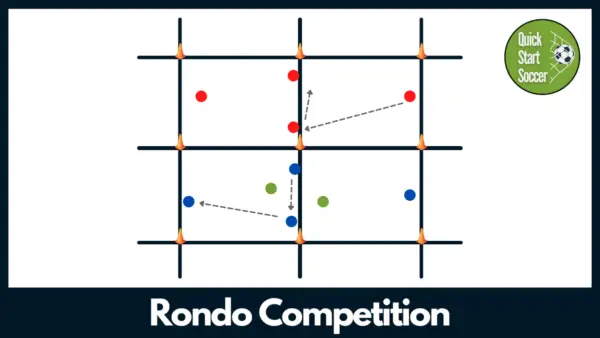
This next rondo drill is a fun twist on the classic 4v2 rondo setup in which players will compete to score as many points as they can while passing and maintaining possession.
How To Set Up The Drill
Split the players up into three teams of 4. Put each team in different color bibs, and choose one team to be the first defending team. Next, set up two 12×15 yard grids and place a non-defending team in a grid each. Prepare a supply of balls outside the grid for quick restarts.
How To Play
Blow your whistle to start the game. At which point, the defending team sends in two players to each grid and they play a 4v2 game. The attacking teams must make 4 consecutive passes to score a point, while the defending team gets points for intercepting the ball and placing the sole of their foot on the ball.
Play three 3-minute games with teams switching roles each time so each team gets a chance to defend. The team that accumulates the most points over all three games is the winner.
For coaching points, coaching tips, and a free PDF of this rondo drill, visit our 4v2 Rondo Competition drill page.
4v2 Switching The Play
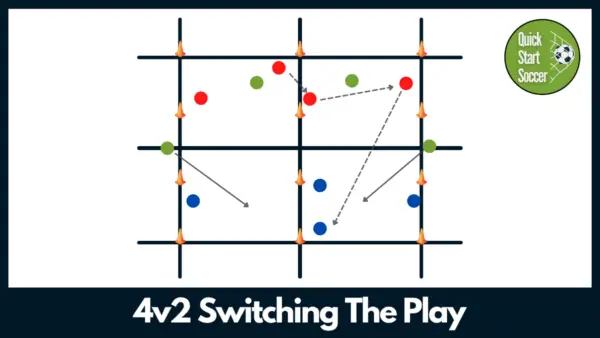
In this fast-paced rondo game, players work on their short and long-range passing, vision, and awareness. Like the rondo drill above, this is another 4v2 game that’s great for practicing passing and receiving.
How To Set Up The Drill
Set up a 40×20 yard grid and then divide the grid into 3 zones as shown in the drill diagram above. Split the teams up into three teams of 4 and put them in different color bibs. You will also need plenty of soccer balls at the ready.
How To Play
Designate two teams as the attacking teams and one of the teams as the defending team. The attacking teams start in the two outer zones, and the defending team start outside the central zone at the halfway point (two players on either side).
One team of attackers starts with the ball, and the defending team sends in two players into their zone to try and win the ball. The attacking team must make at least 4 passes in a row before trying to ‘switch’ the ball to the opposite zone. If the attacking team managers to switch the ball to the other attacking team, the two defenders run back to the halfway point, and then the other two defenders enter the attackers’ zone to try and win possession.
If at any point a member of an attacking team accidentally kicks the ball out of play, or makes an unsuccessful switch, they become the defensive team and the current defending team takes their place.
For coaching points, coaching tips, and a free PDF of this rondo drill, visit our 4v2 Switching The Play drill page.
4v2 To Goal
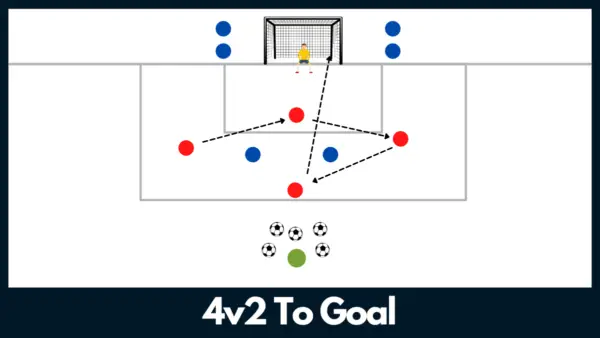
What makes this rondo drill really fun is that it has shooting too! This rondo game is another 4v2 drill that gives players plenty of chances to work on their passing and receiving skills.
How To Set Up The Drill
For this drill, you’ll need a full-size penalty area, or you can use small cones to set up a similar-sized grid. Make two teams of 5 players and put them in two different color bibs. One team will be the attacking team, and one team will be the defending team. The attacking team should start with four players in the penalty area, and one ‘server’ on the outside of the area. The defending team should have one goalkeeper and a line of two players on each side of the goal as shown in the diagram above. Have a supply of balls ready to go for quick restarts.
How To Play
To begin, the ‘server’ plays a ball into one of the attacking players, at which point the defending team sends in one player from each side of the goal. The attacking team must make at least three passes in a row before attempting to shoot and score. If the defending team wins the ball, they should clear it out of play, and then the server plays in another ball. After 5/10 minutes, have teams switch roles and play again. The team that scores the most goals is the winner.
For coaching points, coaching tips, and a free PDF of this rondo drill, visit our 4v2 To Goal Play drill page.
2v2+2 Rondo
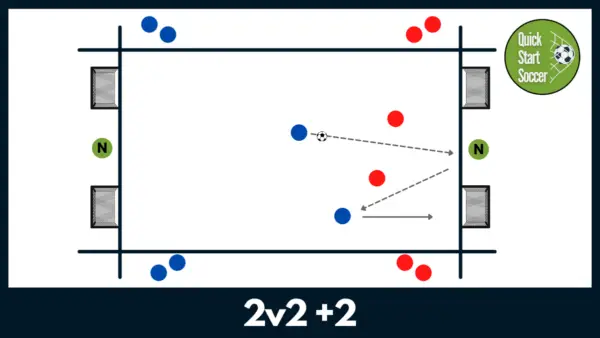
This fun and unique rondo drill can be used as a warm-up activity to practice combination play.
How To Set Up The Drill
Make a 16×20 yard grid with four small goals, as shown in the diagram above. Two goals should be on one side of the grid and two on the other. Choose two players to be the ‘neutral players’ and place them between the goals, one on each side. Make two equal teams with the remaining players and have them line up in 4 groups outside the grid. Have a supply of balls ready for quick restarts.
How To Play
To begin, the coach plays a ball onto the field. The first two people from each team then enter the grid to play a 2v2 game. The neutral players must stay outside the grid but can move from side to side between the goals. The job of the neutral players is to support players on whichever team has possession of the ball.
Whenever a goal is scored, all four players leave the field, and four new players enter. If the ball goes out at any point, play restarts with a kick-in by the non-offending team. Play first to 5/10 goals and then switch out the neutral players.
For coaching points, coaching tips, and a free PDF of this rondo drill, visit our 2v2 +2 drill page.
3 Team Possession
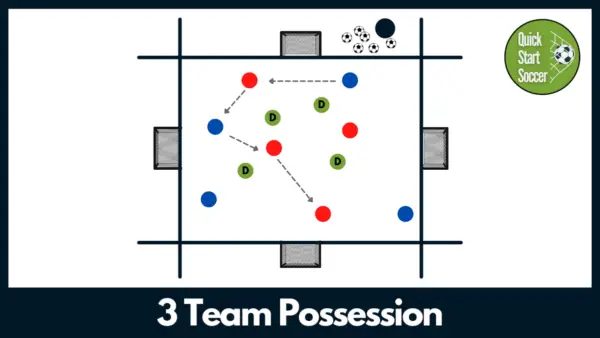
This rondo drill is a highly competitive possession game in which players get to work on their passing and receiving skills, speed of play, decision making, team shape, and movement on the ball.
How To Set Up The Drill
Set up a 30×30 yard grid and place a pug goal on each of the four sides. Split the players up into three teams and put them in different color bibs. Two teams will be attacking teams and one team will be the defending team. Have a supply of balls ready for quick restarts.
How To Play
To start, the coach plays a ball to one of the attaching teams. The two attacking teams then work together to keep possession of the ball. The defending team should try and win the ball. The defending team can win 1 point by forcing the attacking team to kick the ball out accidentally and 2 points if they win the ball and score in one of the 4 pug goals.
Every time a goal is scored, or the ball goes out, the coach plays a new ball into one of the attacking teams, and the game continues. Play for three minutes and then change the defending team. Repeat until each team has had a chance to defend. The team that scores the most points when defending is the winner.
For coaching points, coaching tips, and a free PDF of this rondo drill, visit our 3 team possession drill page.
More Drills And Coaching Resources
Thanks for reading. I hope you found this guide to rondos in soccer useful. Before you go, don’t forget to check out our huge library of free soccer drills and games for inspiration for your next coaching session.

